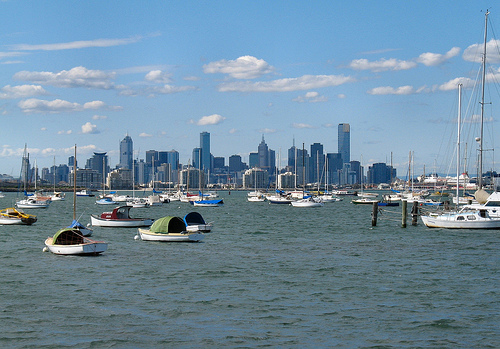Asciano is one of two operators at Swanson Dock, the other being DP World. It has just put forward a proposal to the Victorian State Government to scrap the expansion of Webb Dock into a new container port (which will block the city view from Williamstown foreshore), immediately expand Swanson Dock to cope with increasing cargo, boost Geelong port with a new container terminal operating by 2020 and develop the deepwater port at Hastings so that Melbourne Port can be closed by 2040.
View of Melbourne CBD from Williamstown

Photo by Dean-Melbourne
Expanding the port’s cargo-handling capacity is vital to Victoria’s economy as the Port of Melbourne is Australia’s biggest container port, handling more than 35% of its trade and the freight and logistics sector is Victoria’s largest employer. The container movements is projected to increase from 2 to 8 millions a year by 2035.
This proposed blueprint has many merits. With expected increase in Melbourne’s population from 4 to 7 millions by 2050, expanding the port in Melbourne’s urban centre will be costly as this will further aggravate the congestions in the city’s road and rail corridors. It will make more economic sense to decentralize the port operations to regional Victoria, with two ports at Geelong and Hastings servicing the western and eastern parts of Melbourne respectively. This will create investments and jobs in regional Victoria. Geelong already has major road and rail links, which would minimize costs to build the connecting freight infrastructure.
Swanson and Webb Docks will be freed up for redeveloping into a new waterfront residential and commercial hub on a similiar scale to Docklands.
What are the implications for Altona and the western suburbs? First, it will be more commercially viable for industries in the western suburbs to relocate nearer to Geelong port, probably between Geelong and Werribee, to reduce transport costs and time. The land will also be much cheaper there. Trucks will be taken off Westgate Bridge and the roads in the western suburbs.
Prime industrial land close to Melbourne City will be freed up for residential developments to cope with the population boom. This will be a much better urban design than to develop new residential estates on Melbourne’s fringe, far removed from amenities, infrastructure, public transport and employment opportunities. The shifting out of industries will remove the stigma of the western suburbs being associated with industries and inevitably lead to an increase in their real estate values.
It is my hope that the State Government will take up this proposal. Figures in the logistics industry, such as the transport magnate Lindsay Fox, had already argued against expanding the Port of Melbourne in the centre of the City and advocated a deep-water port at Hastings instead.
Reference Source:
- Move the port by 2040 published by the Age on 4 Sep 2010
- Plan to upgrade port is misguided, says Fox published by the Age on 21 Aug 2006





Yeah saw that in the news and thought geez that sounds like a excellent plan. The freeing up of existing docks area between West Melbourne and Footscray/Seddon area for a new waterfront residential and commercial hub on a similar scale to Docklands will be good too.